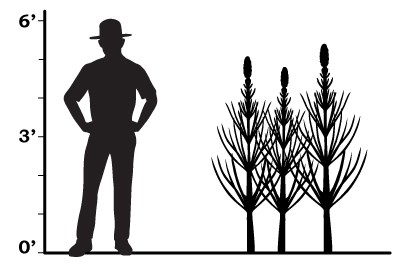
Like a modern horsetail, I reproduced through spores rather than seeds. My long stems are hollow with distinctive joints and ridges. These stalks arise from rhizomes deep underground. Unsplash photo / Jordan Sanchez 
Identification Level: Genus
Horsetail fossils are widespread in the Cantwell Formation of Denali. Fortunately, the tell-tale striations and segmentations allow for easy identification of the specimens to the genus level, and for some specimens to the species Equisetites arcticum. Three different fossil fern and fern foliage genera have been discovered in Denali: Aspleninum, Gleichenia, and Cladophlebis.
Where do I live?
Horsetails lived semi-aquatic lives in marshes and lakes, while ferns flourished in drier soils or sandier parts of the floodplain under the forest canopy.
How do we know I lived in Denali?
Fossil stems and rhizomes of Equisetites have been found near Sable Mountain, Double Mountain, and Polychrome Mountain in Denali. Amazingly, some stems are found relatively uncompressed and are preserved in three-dimensions. This is because the stems are hollow and filled with sediment during burial. Beautifully-preserved fern fronds have also been found in Cretaceous sediments in Denali.

Equisetum, which you can find throughout Denali today, is a “living fossil”. It is the only remaining modern genus of the entire class Equisetopsida, which has dominated forest understories for over 400 million years. |
Last updated: August 16, 2016
